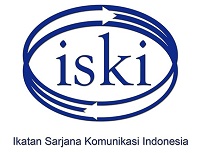Hijrahtainment: Composing Piety and Profane as Commodification of Religion by Media
Abstract
Keywords
Full Text:
PDFReferences
Addini, A. (2019). Fenomena Gerakan Hijrah di Kalangan Pemuda Muslim Sebagai Mode Sosial. Journal of Islamic Civilization, 1(2), 109–118. https://doi.org/10.33086/jic.v1i2.1313
Ahmadi, Dadi & Yohana (2005). Konstruksi Jilbab sebagai Simbol Keislaman. https://doi.org/10.29313/mediator.v8i2.1155
Alansori, M. Z., & Zahidi, S. (2019). Dakwahtaiment Televisi Lokal (Tinjauan Kritis Atas Komesialisasi Dakwah JTV Surabaya). Journal of Islamic Civilization, 1(2), 70–82. https://doi.org/10.33086/jic.v1i2.1341
Amna, A. (2019). Hijrah Artis Sebagai Komodifikasi Agama. Jurnal Sosiologi Reflektif, 13(2), 331. https://doi.org/10.14421/jsr.v13i12.1531
Anisa, F. (2018). Hijrah Milenial: Antara Kesalehan dan Populism. Maarif, Vol.13(No. 2), 38–54. https://scholar.google.co.id/scholar?hl=id&as_sdt=0%2C5&q=tren+berhijrah+di+kalanga++milenial&btnG=#d=gs_qabs&u=%23p%3DTtbLVM96luMJ
Eriyanto. (2012). Analisis Framing: Konstruksi, Ideologi dan Politik Media. LKiS.
Fitri, R. N., & Jayanti, I. R. (2020). Fenomena Seleb Hijrah: Tendensi Ekslusivisme dan Kemunculan Kelompok Sosial Baru. MUHARRIK: Jurnal Dakwah Dan Sosial, 3(01), 1–17. https://doi.org/10.37680/muharrik.v3i01.222
Gerbner, G. & L. G. (2007). Living with Television : The Dynamics of the Cu Itivation Process. https://www.semanticscholar.org/paper/Living-with-Television-%3A-The-Dynamics-of-the-Cu-Gerbner Gross/d376313acb16fcfa8160434ac01a23a8e44cb2dc?p2df
Helen Davis. (2004). The Politics of Representation. In Understanding Stuart Hall. Sage Publications Ltd.
Hjarvard, S. (2008). The mediatization of religion: A theory of the media as agents of religious change. Northern Lights: Film and Media Studies Yearbook, 6(1), 9–26. https://doi.org/10.1386/nl.6.1.9_1
Ispandriamo, L. S. (2016). Agama Dan Media: Pemaknaan Isu Agama Di ‘Detiknews.’ Millah, XII(2), 595–616. https://doi.org/10.20885/millah.volxii.iss2.art13
Lexy J. Moleong. (2000). Metodologi Penelitian Kualitatif. PT. Remaja Rosdakarya.
Mas’udi. (2017). (Menggagas Prinsip-prinsip Etis dalam Jurnalistik). 211–231. http://journal.stainkudus.ac.id/index.php/komunikasi/article/download/434/459
McQuail, D. (2010). Teori Komunikasi Massa (Edisi 6). Salemba HUmanika.
Muttaqin, A. (2012). Agama Dalam Representasi Ideologi Media Massa. KOMUNIKA: Jurnal Dakwah Dan Komunikasi, 6(2). https://doi.org/10.24090/komunika.v6i2.349
Osman, N. A. & M. N. M. (2018). Islamisation in the Indonesian media spaces new sites for a conservative pushNo Title. LJournal of Religious and Political Practice, Volume 4(Islamisation in Southeast Asia: Religion, Politics and Beyond).
Prasanti, D., & Indriani, S. S. (2019). Konstruksi Makna Hijrah Bagi Anggota Komunitas Let’S Hijrah Dalam Media Sosial Line. Al-Izzah: Jurnal Hasil-Hasil Penelitian, 14(1), 106. https://doi.org/10.31332/ai.v14i1.1253
Rahmiatie, Atie (2002). Paradigma Baru Dakwah Islam: Perspektif Komunikasi Massa. Mediator: Jurnal Komunikasi, https://doi.org/10.29313/mediator.v3i1.761
Rakhmani, I. (2016). Mainstreaming Islam in Indonesia. In Mainstreaming Islam in Indonesia. https://doi.org/10.1057/978-1-137-54880-1
Setiawan, E. (2017). Makna Hijrah Pada Mahasiswa Fikom Unisba di Komunitas (followers) Account LINE@DakwahIslam. Mediator: Jurnal Komunikasi, 10(1), 97–108. https://doi.org/10.29313/mediator.v10i1.2152
Suci Wahyu Fajriani1, Y. S. S. (2019). Hijrah Islami Milenial Berdasarkan Paradigma Berorientasi Identitas. Sosioglobal : Jurnal Pemikiran Dan Penelitian Sosiologi, Vol. 3, No(5).
Sugiyono. (2010). Metode Penelitian Pendidikan Pendekatan Kuantitatif, Kualitatif Alfabeta, dan R&DNo Title. Alfabeta.
Sunesti, Y., Hasan, N., & Azca, M. N. (2018). Young Salafi-niqabi and hijrah: Agency and identity negotiation. Indonesian Journal of Islam and Muslim Societies, 8(2), 173–198. https://doi.org/10.18326/ijims.v8i2.173-197
Syahputra, I. (2016). Agama Di Era Media: Kode Religius dalam Industri Televisi Indonesia. ESENSIA: Jurnal Ilmu-Ilmu Ushuluddin, 17(1), 125. https://doi.org/10.14421/esensia.v17i1.1283
Syahrin, A. A., & Mustika, B. (2020). Makna Hijrah Bagi Kalangan Remaja Non Santri: Dampak Penggunaan Media Sosial. Jurnal Studi Agama Dan Masyarakat, 16(1), 61–72. https://doi.org/10.23971/jsam.v16i1.1901
Zahara, M. N., Wlidan, D., & Komariah, S. (2020). Gerakan Hijrah : Pencarian Identitas Untuk Muslim Milenial di Era Digital. Indonesian Journal of Sociology, Education, and Development, 2(1), 58–70.
Dari Hijab Hingga Hijrah. https://historia.id/kultur/articles/dari-hijab-hingga-hijrah accessed Sunday, August 30th, 03.05 p.m.
Arus Balik Hijrah. https://www.suaraislam.co/arus-balik-hijrah/ accessed Sunday, August 30th, 03.15 p.m.
When religion becomes a commodity. https://www.straitstimes.com/opinion/when-religion-becomes-a-commodity accessed Sunday, August 30, 03.20 p.m.
DOI: https://doi.org/10.29313/mediator.v13i2.6610
Refbacks
- There are currently no refbacks.

This work is licensed under a Creative Commons Attribution 4.0 International License























